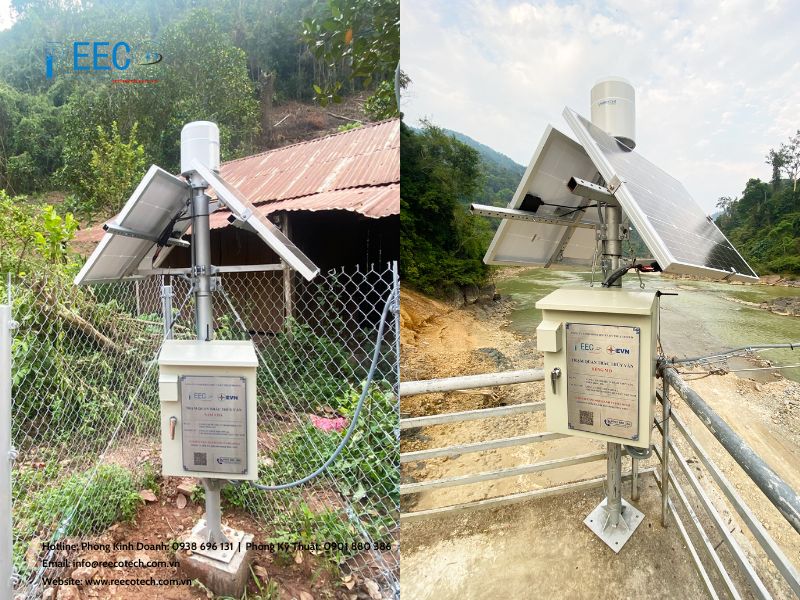Meteorological and hydrological monitoring plays a pivotal role in diverse sectors, as emphasized by the Vietnamese government’s detailed regulations mandating such monitoring for specific constructions. In this article, Reecotech delves into the 10 types of constructions that require meteorological and hydrological monitoring.

What is Meteorological and Hydrological Monitoring?
Meteorological and hydrological monitoring encompasses the systematic observation and measurement, either directly or indirectly, of various parameters that represent the state, phenomena, and evolution of the atmosphere, rivers, streams, canals, ditches, lakes, and seas. In essence, it involves gathering data on a wide range of factors, including:
- Meteorological: Temperature, pressure, humidity, precipitation, wind, and solar radiation within the atmosphere.
- Hydrological: Water levels, flow rates, and water quality characteristics of rivers, streams, canals, ditches, lakes, and seas.
Extensive meteorological and hydrological monitoring networks are established across various regions, providing a wealth of continuous information on weather and water conditions. By analyzing the collected data, humans can achieve more accurate weather forecasting, effectively manage water resources, predict floods, conduct climate change research, and support diverse applications in various fields.
Why is Meteorological and Hydrological Monitoring Essential?
Meteorological and hydrological monitoring plays a pivotal role in diverse fields, offering immense benefits to society and the environment. Its significance lies in its ability to provide comprehensive insights into weather patterns, water resources, and potential hazards, enabling informed decision-making and effective risk mitigation strategies.
- Accurate Weather Forecasting: Provides information about current and future weather conditions, empowering individuals and communities to effectively prepare for and respond to extreme weather events such as storms, floods, droughts, and heatwaves.
- Sustainable Water Resource Management: Monitors water flow and levels, aiding in flood prediction, rational water allocation, ensuring reservoir safety, and promoting sustainable water resource management practices.
- Climate Change Research: Furnishes data for climate change research, enabling scientists to track and understand the impacts of climate change on the environment, develop adaptation strategies, and implement timely mitigation measures.
- Enhanced Transportation Safety: Provides information on visibility, wind speed, and weather conditions, contributing to improved transportation safety, particularly during challenging weather conditions such as fog, heavy rain, and strong winds.
- Diverse Applications: The information gathered from meteorological and hydrological monitoring stations finds wide-ranging applications in various sectors, including agriculture, electricity, aviation, and many more. This enables proactive prevention and response to potential incidents, ensuring the safety of production activities and daily life.
Meteorological and hydrological monitoring stands as an essential practice, offering a multitude of practical benefits to humanity. Investing in modern and efficient meteorological and hydrological monitoring systems will contribute to environmental protection, economic and social development, and an overall enhanced quality of life for all.
10 Types of Constructions Requiring Meteorological and Hydrological Monitoring
Decree No. 48/2020/ND-CP (amending and supplementing some articles of Decree No. 38/2016/ND-CP) specifies 10 types of constructions that are required to conduct meteorological and hydrological observations, including:
- Civil airports;
- Dams, reservoirs of special importance, large and medium-sized types as regulated by the Government’s regulations on the safety management of dams, reservoirs, as well as reservoirs within the regulated scope of the operation process of inter-reservoir operation within river basins;
- Ports belonging to Type I and Type II seaports based on the list of seaports and ports belonging to seaports in Vietnam published by the Ministry of Transport.
- For seaports with multiple wharves, organizations shall consult the state management agencies on resources, environment, and local meteorological and hydrological agencies to select and designate representative wharves for observation. The remaining wharves have the right to share, exploit observation information, and contribute funds to provide and observe meteorological and hydrological information data.
- Bridges with a span for boat passage over 500 meters;
- Broadcasting and television transmission towers combined with sightseeing, business, and serving tourists on the towers;
- Cable cars serving tourism and sightseeing activities;
- National parks;
- Highway routes in areas with hazardous weather conditions, determined in risk zones published and updated by the General Department of Meteorology and Hydrology under the Ministry of Natural Resources and Environment every 3 years;
- Integrated inland water ports from Type I and above;
- Specialized constructions including islands in the Truong Sa archipelago, rigs in the Economic-Technical Service clusters (DK1), and military airports serving security and defense purposes;
Additionally, the Decree also mentions regulations for owners of these constructions. Owners of the constructions must install meteorological and hydrological observation stations and ensure the funds to organize observations, provide meteorological and hydrological data and information as regulated.
Through this article, it is hoped that you have gained an understanding of the regulations on constructions required to conduct meteorological and hydrological observations according to Decree No. 48/2020/ND-CP. Meteorological and hydrological observations play a crucial role in protecting the safety of constructions, ensuring efficient production and business activities, and contributing to environmental protection. Furthermore, if you have any further inquiries regarding the installation of meteorological and hydrological observation stations, please contact Reecotech hotline at 093806960131 for detailed advice and support!
If you have any further questions about installing meteorological and hydrological observation stations, please feel free to contact us for free consultation and support. We are always ready to answer any questions and provide the most suitable solutions for your needs.


